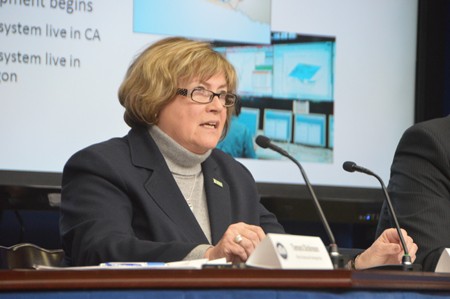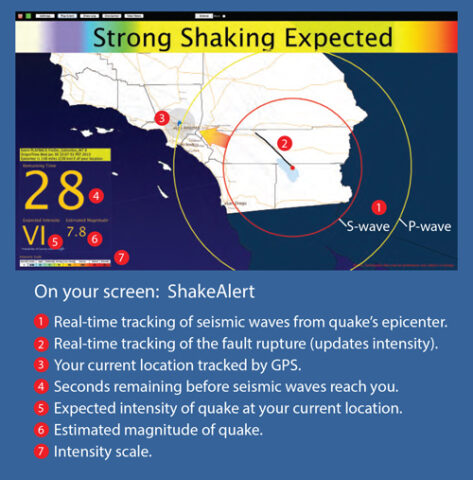With 143 million Americans in the continental United States at risk of experiencing a potentially damaging earthquake, efforts to create an early warning system and maintain government preparedness are moving forward, according to officials at a recent White House summit on earthquake resilience. The event highlighted the warning system and a new presidential executive order on earthquake standards for federal buildings.
“Earthquake early warning is coming,” said Suzette Kimball, director of the U.S. Geological Survey (USGS), who announced that the agency and its partners in government, academia, and the private sector have reached an important milestone in the development of the earthquake ShakeAlert warning system funded by USGS and the Gordon and Betty Moore Foundation.
“This month, we will complete the ShakeAlert production prototype system and begin transitioning the approximately 75 current test users to the production system that will be generating actionable alerts,” she said at the 2 February summit. USGS and its partners rolled out the production prototype in California the day before the White House event.

Kimball said that the production prototype’s users—which include government offices, schools, mass transit systems, and others—will be able to develop and test limited practical applications like opening fire station doors, stopping elevators, and alerting emergency personnel.
After building on the current prototype to create a robust system for the West Coast, where about three quarters of the risk in the United States is concentrated, the ShakeAlert developers plan to expand the system to other regions, according to Kimball.
“Our goal is to have that ShakeAlert system in place in the United States before we realize casualties and a property loss on [grand] scales.”
“Our goal is to have that ShakeAlert system in place in the United States before we realize casualties and a property loss on [grand] scales,” said Kimball, who emphasized the need for support from Congress and others for the system. She noted that Japan and some other countries already have early warning systems in place.
Maryland state geologist Richard Ortt, a summit participant, told Eos that it makes sense to put the warning resources on the West Coast first and that “once they demonstrate their ability, then that technology can march across the country and protect us [in Maryland] just as much as it’s protecting the Pacific.”
Early Warning
The earthquake early warning system deploys “sensors across earthquake-prone regions so we can detect the earthquake when it nucleates at the beginning of the rupture, assess how big it is going to be, and push an alert out to the people who are in harm’s way,” said Richard Allen, director of the Berkeley Seismological Laboratory in California, a partner in the ShakeAlert project. The project’s developers have designed it to transmit alerts through smartphones, radio, television, and other communication systems, he said.
In addition to the warnings triggering automated controls of train speeds and safeguards for chemicals and sensitive data, they can also potentially cut in half the number of personal injuries from earthquakes by giving people time to take cover, Allen said. More than 50% of injuries from California’s 1989 Loma Prieta and 1994 Northridge earthquakes resulted from nonstructural falling hazards such as ceiling tiles and light fixtures, he noted.

U.S. Rep. Adam Schiff (D-Calif.) said Congress appropriated $8.2 million for ShakeAlert in last year’s budget and $5 million in 2014, which he said shows “the growing awareness and bipartisan character of this effort.” The Obama administration’s proposed budget for fiscal year 2017 also includes $8.2 million for the earthquake early warning system.
The idea of disaster resilience “has picked up momentum” over the past few years, in part because of strong science, the boom in smartphones that can double as pocket warning systems, and the fact that “it’s fairly apolitical because everyone sees some value in being resilient,” Elizabeth Eide, director of the U.S. National Research Council’s Board on Earth Sciences and Resources, told Eos.
Executive Order
An executive order issued by the White House the same day as the summit establishes a federal earthquake risk management standard. It also calls for potential retrofits and other measures to ensure that federal buildings can function after an earthquake and to protect their occupants.
“Especially in the immediate aftermath of an earthquake is the one time when all of us want our government to be effective,” said USGS seismologist Lucy Jones, who described the executive order as an important measure for maintaining urban disaster resilience. “We cannot lose government when we need it the most,” she said.
The executive order “paves the way for state and local agencies to adopt and enforce these important building codes and standards as well.”
David Applegate, USGS associate director for natural hazards, told Eos that the executive order “is driving the adoption and use of modern building codes for federal facilities, with the codes based on USGS national seismic hazard maps.”
The executive order “paves the way for state and local agencies to adopt and enforce these important building codes and standards as well,” Lisa Grant Ludwig, past president of the Seismological Society of America and chair of its Government Relations Committee, told Eos.
—Randy Showstack, Staff Writer
Citatin: Showstack, R. (2016), White House showcases earthquake alerts, federal quake readiness, Eos, 97, doi:10.1029/2016EO046635. Published on 22 February 2016.
Text © 2016. The authors. CC BY-NC 3.0
Except where otherwise noted, images are subject to copyright. Any reuse without express permission from the copyright owner is prohibited.

